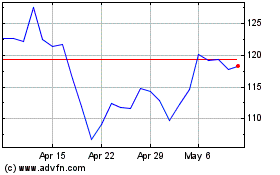By Elizabeth Koh and Asa Fitch
With much of the world in lockdown, internet users are logging
billions of hours of additional screen time as daily life goes
virtual.
That increase has seen data centers beef up their infrastructure
to meet demand, a trend that is bolstering the businesses that make
components for the servers that store data and power the world's
Zoom calls, Amazon sprees and Netflix binges.
Some of the world's biggest memory chip makers, South Korea's
Samsung Electronics Co. and SK Hynix Inc. and Boise, Idaho-based
Micron Technology Inc., say that boost has been welcome in an
otherwise challenging environment. At Micron, sales in its February
quarter fell but were near the high end of management's guidance
range due partly to data-center demand. At SK Hynix, average
selling prices for some chips rose slightly in the last quarter,
pushed by demand for servers.
Intel Corp., the largest U.S. chip maker, said last week that
data-center sales surged by 43% in its first quarter, driven by
demand for its computer-processing units. Demand for other
processors for personal computers have also gone up as people buy
equipment for remote working, Intel said.
To some extent, the rising demand for data-center equipment
merely counters falling demand for other electronic components as
coronavirus craters the global economy. Analysts still expect a
decline in semiconductor sales globally this year, but for now
demand remains strong.
The increased spending on memory chips has been led by
heavyweight cloud providers such as Amazon.com Inc. and Microsoft
Corp., which have both seen dramatic increases in usage.
Suppliers are adapting fast. SK Hynix, which makes DRAM and NAND
flash memory chips, said Thursday that it planned to raise
production and increase sales of certain memory chips.
Micron Chief Executive Sanjay Mehrotra said last month that he
was shifting production capacity away from chips for smartphones
and cars toward data-center products. Prices for digital storage
and memory are holding up since the start of the pandemic.
While the memory-chip bump may be temporary, suppliers to the
cloud can expect the rising demand to last "at least as long as the
shutdowns," said Kuba Stolarski, an analyst at market-research firm
IDC. As people become more accustomed to conducting daily life
online, that usage may stick, he said.
In March, internet users world-wide logged an extra 5 billion
hours of screen time on the 100 most popular websites, such as
Google and Facebook, according to analytics firm SimilarWeb. That
marked a 13% increase from February and the largest monthly rise in
recent years.
Businesses are seeking more cloud services to support remote
work and increased screen time.
Zoom Video Communications Inc., whose video chat rooms host
meetings and cocktail parties, is adding capacity through servers
and other equipment in its data centers and cloud services, as it
also addresses privacy and security concerns raised amid a massive
surge in users.
YouTube, Amazon and Netflix Inc.--which alone added a record
15.77 million new monthly subscribers in the last quarter--have
throttled their streaming speeds in Europe along with
competitors.
Many data centers deliberately operate at less than peak
capacity to account for surges in traffic or potential new clients
who might move their business into the cloud. That buffer has kept
users from hitting serious issues including sustained outages
during the pandemic, industry experts said.
But with no signs that usage will let up, the largest cloud
companies, such as Amazon Web Services and Microsoft Azure, are
working to maintain that buffer, said Andrew Perlmutter, the chief
strategy officer for ITRenew Inc., which refurbishes and resells
data-center equipment.
Besides increasing purchases, some major cloud providers are
keeping older equipment longer and using software to more
efficiently manage data, Mr. Perlmutter said.
Chip companies focused solely on the data-center market have
done particularly well during the crisis. Inphi Corp., for example,
a California-based maker of semiconductor networking components
that go into data-center equipment, on Tuesday said sales were
higher than initially expected in the first quarter as a result of
faster upgrades of equipment and demand for more bandwidth.
The boom time for chip makers may be brief, given the industry's
sensitivity to supply and demand, analysts say. Some cloud
providers are buying up inventory now in anticipation of a second
coronavirus wave, potentially denting sales later in the year, they
said.
A deeper hit to the world's economy could sting, warned Jin-Seok
Cha, SK Hynix's head of finance and vice president. "If the
economic downturn is prolonged, we cannot discount the possibility
that even server demand could weaken," he said.
Write to Elizabeth Koh at Elizabeth.Koh@wsj.com and Asa Fitch at
asa.fitch@wsj.com
(END) Dow Jones Newswires
April 28, 2020 05:44 ET (09:44 GMT)
Copyright (c) 2020 Dow Jones & Company, Inc.
Micron Technology (NASDAQ:MU)
Historical Stock Chart
From Mar 2024 to Apr 2024

Micron Technology (NASDAQ:MU)
Historical Stock Chart
From Apr 2023 to Apr 2024
